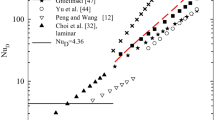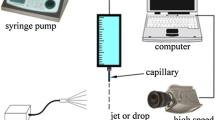Abstract
Pressure drops were measured for high-velocity water flows through micro-orifices of various diameters. The observed pressure drop values agreed well with the values predicted by the Navier–Stokes equation for 400 and 100 μm diameter orifices, but were lower than the predicted values for orifices less than 50 μm in diameter. In particular, the measured pressure drop value was almost two orders of magnitude lower than the predicted value for the 10 and 5 μm diameter orifices. Several factors that may cause a reduction in pressure drop were considered, including orifice shape and deformation of the orifice foil, but none proved to be significant enough to cause such a large reduction. Elastic stress in orifice flow appeared to be the most plausible cause of the pressure drop reduction. The elastic stress, which was estimated by the jet thrust method, was found to be dependent on the mean velocity passing through the micro-orifices, which strongly supported the elasticity of water flows.









Similar content being viewed by others
References
Astarita G, Greco G (1968) Excess pressure drop in laminar flow through sudden contraction. Newtonian liquids. Ind Eng Chem Fundam 7:27–31
Bakhtiyarov SI, Overfelt RA (2000) Rheology of refractory coating materials used in lost foam casting process. J Elastomer Plast 32:73–85
Boger DV, Denn MM (1980) Capillary and slit methods of normal stress measurements. J Non-Newton Fluid Mech 6:163–185
Bond WN (1921) Viscosity determination by means of orifices and short tubes. Proc Phys Soc Lond 34:139–144
Dagan Z, Weinbaum S, Pfeffer R (1982) An infinite-series solution for the creeping motion through an orifice of finite length. J Fluid Mech 115:505–523
Derdouri A, Ait-Kadi A, Carreau PJ (1988) Rheological properties of polymer-added lubricating oils. Can J Chem Eng 66:709–713
Happel J, Brenner H (1965) Low Reynolds number hydrodynamics: with special applications to particulate media. Kluwer Academic Publishers Group, Distribution Center, Netherlands
Hasegawa T (1979) Measurement of the first normal stress differences of water and dilute polymer solutions. Bull JSME 22:54–62
Hasegawa T, Iwaida T (1984) Experiments on elongational flow of dilute polymer solutions Part I: jet reaction and excess pressure drop for the flow through small apertures. J Non-Newton Fluid Mech 15:257–277
Hasegawa T, Nakamura H (1991) Experimental study of the elongational stress of dilute polymer solutions in orifice flows. J Non-Newton Fluid Mech 38:159–181
Hasegawa T, Suganuma M, Watanabe H (1997) Anomaly of excess pressure drops of the flow through very small orifices. Phys Fluids 9:1–3
Hasegawa T, Asama H, Narumi T (2003) A simple method for measuring elastic stresses by jet thrust and some characteristics of tube flows. Nihon Reoroji Gakkaishi 31:243–252
Hasegawa T, Ushida A, Narumi T (2009) Huge reduction in pressure drop of water, glycerol/water mixture and aqueous solution of polyethylene oxide in high speed flows through micro-orifices. Phys Fluids 21:052002
Hsiai TK, Cho SK, Yang JM, Yang X, Tai YC, Ho CM (2002) Pressure drops of water flow through micromachined particle filters. J Fluids Eng-Trans ASME 124:1053
Jeong JT, Choi SR (2005) Axisymmetric Stokes flow through a circular orifice in a tube. Phys Fluids 17:053602
Johansen FC (1930) Flow through pipe orifices at low Reynolds numbers. Proc R Soc Lond A 126:231–245
Kohl MJ, Abdel-Khalik SI, Jeter SM, Sadowski DL (2005) An experimental investigation of microchannel flow with internal pressure measurements. Int J Heat Mass Transf 48:1518–1533
Kusmanto F, Jacobsen EL, Finlayson BA (2004) Applicability of continuum mechanics to pressure drop in small orifices. Phys Fluids 16:4129
Lodge AS (1989) An attempt to measure the first normal-stress difference N1 in shear flow for a polyisobutylene/decalin solution “D2b” at shear rates up to 106 s−1. J Rhel 33:821–841
Mala GM, Li D (1999) Flow characteristics of water in microtubes. Int J Heat Fluid Flow 20:142–148
McCarthy MJ, Molloy NA (1974) Review of stability of liquid jets and the influence of nozzle design. Chem Eng J 7:1–20
Mishra C, Peles Y (2005) Incompressible and compressible flows through rectangular microorifices entrenched in silicon microchannels. J Microelectromech Syst 41:1000–1012
Oliver DR, MacSporran WC (1969) Normal stress measurement by means of a jet thrust apparatus. Rheol Acta 8:176–183
Peng XF, Peterson GP (1996) Convective heat transfer and flow friction for water flow in microchannel structures. Int J Heat Mass Transf 39:2599–2608
Peng XF, Peterson GP, Wang BX (1994) Frictional flow characteristics of water flowing through rectangular microchannels. Exp Heat Transf 7:249–264
Pfahler J, Harley J, Bau H, Zemel J (1989) Liquid transport in micron and submicron channels. Sens Actuators A Phys 22:431–434
Pfund D, Rector D, Shekarriz A, Popescu A, Welty J (2000) Pressure drop measurements in a microchannel. AIChE J 46:1496–1507
Qu W, Mala GM, Li D (2000) Pressure-driven water flows in trapezoidal silicon microchannels. Int J Heat Mass Transf 43:353–364
Roscoe R (1949) The flow of viscous fluids round plane obstacles. Philos Mag 40:338–351
Sampson RA (1891) On Stokes’s current function. Philos Trans R Soc Lond A 182:449–518
Sharp KV, Adrian RJ (2004) Transition from laminar to turbulent flow in liquid filled microtubes. Exp Fluids 36:741–747
Sparrow EW, Lin SH, Lundgren TS (1964) Flow development in the hydrodynamic entrance region of tubes and ducts. Phys Fluids 7:338–347
Sylvester ND, Chen HL (1985) Notes: excess pressure losses in a sudden contraction. J Rheol 29:1027–1033
Tomita Y, Mochimaru Y (1980) Normal stress measurement of dilute polymer solutions. J Non-Newton Fluid Mech 7:237–255
Ushida A, Hasegawa T, Narumi T (2010) Drag reduction for liquid flow through micro-apertures. J Non-Newton Fluid Mech 165:1516–1524
Ushida A, Hasegawa T, Kawami M, Uchiyama H, Narumi T, Kayaba R (2012a) Flow properties of microbubble/polyethylene glycol mixtures passing through orifices and slits. Nihon Reoroji Gakkaishi 40:61–68
Ushida A, Hasegawa T, Hoshina T, Kudou S, Uchiyama H, Narumi T (2012b) Measurement and observation of jet thrust for water flow through micro-orifice. J Fluids Eng-Trans ASME 134:081201
Vleggaar J, Tels M (1972) Apparatus for measuring laminar jet thrust. J Phys E Sci Instrum 5:1200–1202
Wilding P, Pfahler J, Bau HH, Zemel JN, Kricka LJ (1994) Manipulation and flow of biological fluids in straight channels micromachined in silicon. Clin Chem 40:43–47
Wu HY, Cheng P (2003) Friction factors in smooth trapezoidal silicon microchannels with different aspect ratios. Int J Heat Mass Transf 46:2519–2525
Xu B, Ooti KT, Wong NT, Choi WK (2000) Experimental investigation of flow friction for liquid flow in microchannels. Int J Heat Mass Transf 27:1165–1176
Young DF, Tsai FY (1973) Flow characteristics in models of arterial stenoses-I. Steady flow. J Biomech 6:395–402
Acknowledgments
We wish to thank Mr. Ryuichi Kayaba, Mr. Masanao Takahashi, Mr. Hiroteru Haruyama, Mr. Takehiro Hoshina, Mr. Shouta Kudou, Mr. Masato Kawami, and Mr. Hiroshige Uchiyama for assistance in the experiments. We also thank the CFIL members of Niigata University for helpful comments and suggestions. A part of this study was financially supported by Grant for Promotion of Niigata University Research Projects.
Author information
Authors and Affiliations
Corresponding author
Rights and permissions
About this article
Cite this article
Ushida, A., Hasegawa, T. & Narumi, T. Anomalous phenomena in pressure drops of water flows through micro-orifices. Microfluid Nanofluid 17, 863–870 (2014). https://doi.org/10.1007/s10404-014-1362-6
Received:
Accepted:
Published:
Issue Date:
DOI: https://doi.org/10.1007/s10404-014-1362-6




